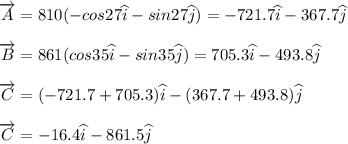
Physics, 03.07.2021 06:30 bollipard1183
URGENT
A student runs at 4.5 m/s [27° S of W] for 3.0 minutes and then he turns and runs at 3.5 m/s [35° S of E] for 4.1 minutes.
a. What was his average speed?
b. What was his displacement?
PLEASE SHOW ALL WORK

Answers: 3


Other questions on the subject: Physics

Physics, 22.06.2019 00:20, nini261
2.22/3.33 points | previous answers tamucolphysmechl1 4.pre.002. ask your teacher my notes question part points submissions used on a frictionless air track, a blue glider with mass 0.200 kg is moving to the right with a speed of 8.00 m/s. it strikes a red glider that has mass 0.600 kg and that is initially at rest. after the collision, the blue glider is moving to the left with a speed of 2.40 m/s. (a) what are the magnitude and direction of the velocity of the red glider after the collision? magnitude 3.33 m/s correct: your answer is correct. direction correct: your answer is correct. (b) is this collision elastic?
Answers: 1

Physics, 22.06.2019 01:40, sasalinas2001
In all trials, the magnitude of the final velocity for g1 + g2 was less than the magnitude of any initial velocity. as mass increased, what happened to the velocity? the velocity decreased. the velocity increased. the velocity of g1 + g2 could not be measured. the velocity was not affected by the mass increase.
Answers: 1

Physics, 22.06.2019 10:00, kenna0
This is important 1. what happens to the speed of molecules in water vapor when it condenses to form a liquid? (2 points) the molecules slow down. the molecules speed up. the molecules slow down and then speed up. the molecules speed up and then slow down. 2. how might human activities change to compensate for a decrease in water supplies? (2 points) humans might build a factory. humans might build drainage systems. humans might extract more water from the ground. human behavior does not change because of the water cycle. i'll be grateful if anyone can answer these 2 questions !
Answers: 1

Physics, 22.06.2019 12:30, tigistamare03
When a vertical beam of light passes through a transparent medium, the rate at which its intensity i decreases is proportional to i(t), where t represents the thickness of the medium (in feet). in clear seawater, the intensity 3 feet below the surface is 25% of the initial intensity i0 of the incident beam. what is the intensity of the beam "10" feet below the surface? (give your answer in terms of i0. round any constants or coefficients to five decimal places.)
Answers: 2
You know the right answer?
URGENT
A student runs at 4.5 m/s [27° S of W] for 3.0 minutes and then he turns and runs at 3.5 m/s...
Questions in other subjects:



Mathematics, 18.03.2021 23:10

Mathematics, 18.03.2021 23:10

Spanish, 18.03.2021 23:10


Biology, 18.03.2021 23:10

English, 18.03.2021 23:10

Biology, 18.03.2021 23:10






